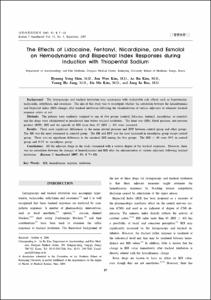KUMEL Repository
1. Journal Papers (연구논문)
1. School of Medicine (의과대학)
Dept. of Anesthesiology & Pain Medicine (마취통증의학)
The Effects of Lidocaine, Fentanyl, Nicardipine, and Esmolol on Hemodynamic and Bispectral Index Responses during Induction with Thiopental Sodium
- Keimyung Author(s)
- Kim, Ae Ra; Jang, Young Ho; Kim, Jin Mo; Bae, Jung In
- Journal Title
- Korean Journal of Anesthesiology
- Issued Date
- 2007
- Volume
- 53
- Issue
- 3
- Abstract
- Background The laryngoscopy and tracheal intubation may accompany with undesirable side effects such as hypertension, tachycardia, arrhythmia, and awareness. The aim of this study was to investigate whether the correlation between the hemodynamics and bispectral index (BIS) changes after tracheal intubation following the administration of various adjuvants to attenuate tracheal response exists or not. Methods The patients were randomly assigned to one of five groups (control, lidocaine, fentanyl, nicardipine, or esmolol) and the drugs were administered at preselected time before tracheal intubation. The heart rate (HR), blood pressure, rate-pressure product (RPP), BIS and the episode of BIS more than 65 (BIS ≥ 65) were measured. Results There were significant differences in the mean arterial pressure and RPP between control group and other groups. The HR was the most attenuated in esmolol group. The HR and RPP was the most increased in nicardipine group except control group. There was no significant difference in the maximal BIS among the five groups. The BIS ≥ 65 were 50% in control group and 0.3% in nicardipine group. Conclusions All the adjuvant drugs in the study attenuated with a various degree of the tracheal responses. However, there was no correlation between the changes of hemodynamics and BIS after the administration of various adjuvants following tracheal intubation.
- Publisher
- School of Medicine
- Citation
- Hyoung Yong Shin et al. (2007). The Effects of Lidocaine, Fentanyl, Nicardipine, and Esmolol on Hemodynamic and Bispectral Index Responses during Induction with Thiopental Sodium. Korean Journal of Anesthesiology, 53(3), S7-13.
- Type
- Article
- ISSN
- 2005-6419
- Appears in Collections:
- 1. School of Medicine (의과대학) > Dept. of Anesthesiology & Pain Medicine (마취통증의학)
- 파일 목록
-
-
Download
 oak-bbb-05532.pdf
기타 데이터 / 248.92 kB / Adobe PDF
oak-bbb-05532.pdf
기타 데이터 / 248.92 kB / Adobe PDF
-
Items in Repository are protected by copyright, with all rights reserved, unless otherwise indicated.